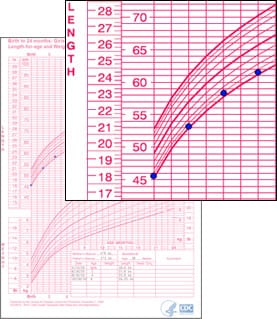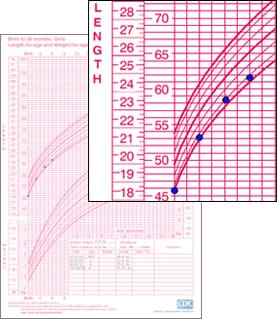Case Example 2: Inadequate Growth or Just Small
Carmen is a 6-month-old girl who was 18.0 inches long at birth.
| Date of Visit | Age (months) | Length (inches) | WHO Percentile | CDC Percentile |
|---|---|---|---|---|
| 4/15/2010 | Birth | 18.0 | 3 | 6 |
| 6/16/2010 | 2 | 21.0 | 3 | 8 |
| 8/16/2010 | 4 | 23.0 | 2 | 7 |
| 10/18/2010 | 6 | 24.25 | 3 | 8 |
| Comparing Length-for-Age Plotted on the WHO and CDC Growth Charts | |
|---|---|
|
WHO Length-for-Age Growth Chart
|
CDC Length-for-Age Growth Chart
|
Using the CDC Length-for-Age Growth Chart
Carmen’s length is plotted on the CDC growth chart and her length-for-age tracks between the 5th and 10th percentiles from birth through 6 months of age. On the CDC length-for-age chart, length-for-age below the 5th percentile indicates low length-for-age.
Carmen’s length-for-age tracks along the lower percentiles indicating that she is small which is not unexpected considering the height of her parents. Although she is small, she is following a healthy growth centile curve.
Carmen’s healthcare provider needs to continue to monitor Carmen’s growth and determine if and when it is appropriate to intervene.
Comment: Plotting Carmen’s length-for-age on both the WHO and the CDC growth charts shows a healthy growth pattern although it is in the lower percentiles on both charts.
Health care providers should note that the differences in length are small between the WHO and the CDC charts, and the clinical differences may be insignificant. The prevalence of low length-for-age (short stature) is similar for the WHO and CDC length-for-age charts when low length-for-age is defined as < 2nd percentile on the WHO growth charts and < 5th percentile on the CDC growth charts.

